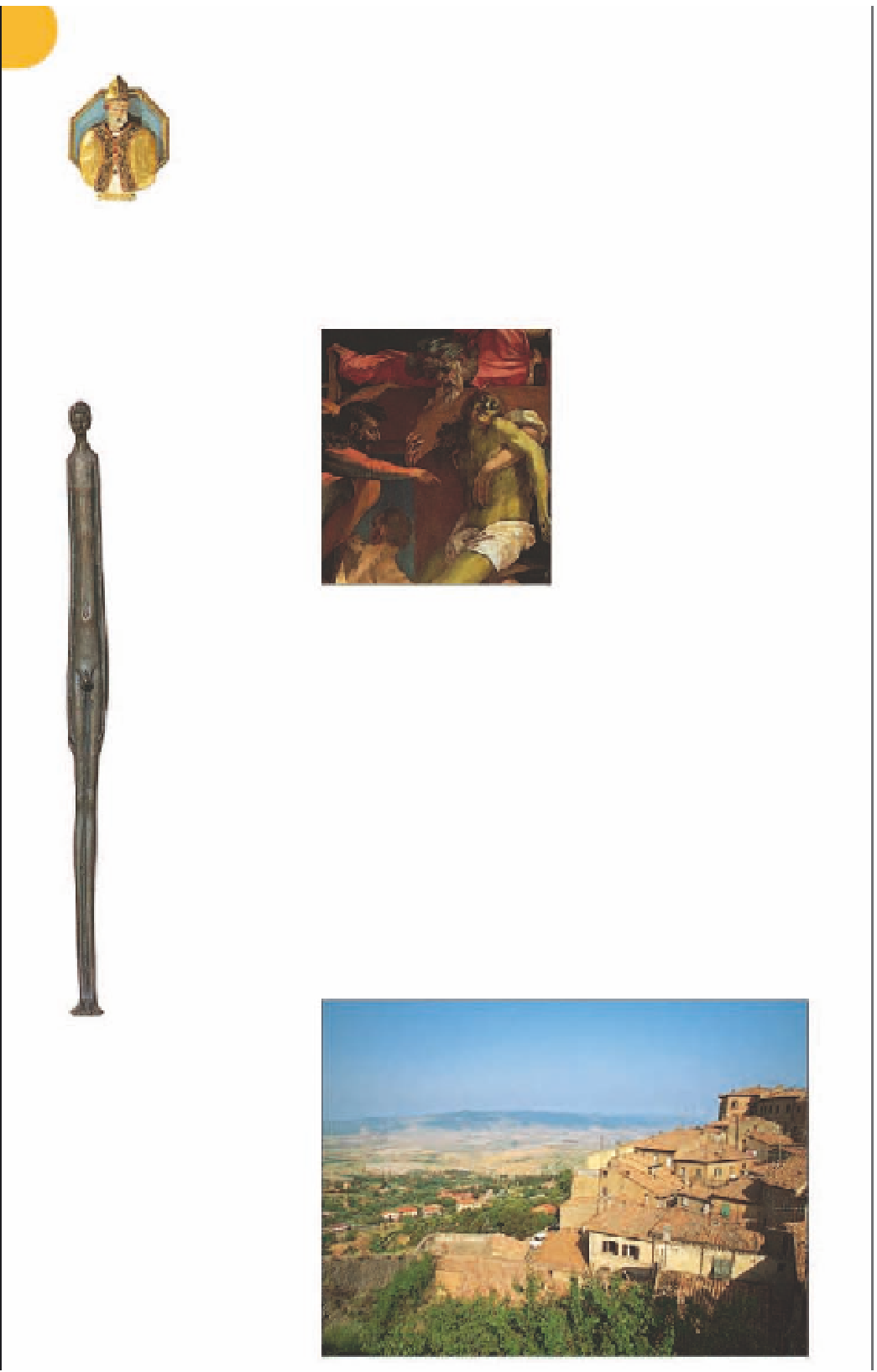Travel Reference
In-Depth Information
Volterra
r
Situated, like many Etruscan cities, on a
high plateau, Volterra offers uninterrupted
views over the surrounding hills. In many
places the ancient Etruscan walls still
stand. Volterra's famous Museo Guarnacci
contains one of the best collections of
Etruscan artifacts in Italy. Many of the
exhibits were gathered from the numerous
local tombs. After its museums and medieval buildings,
the city is famous for its craftsmen who carve beautiful
white statues from locally mined alabaster.
slip like the one shown in the
middle distance and beyond.
Luca Signorelli's
Madonna
and Child with Saints
(1491)
shows his debt to Roman art
through the reliefs on the
base of the Virgin's throne.
His
Annunciation
(1491) is
another beautiful composition.
The museum's main exhibit
is Rosso Fiorentino's Mannerist
work
(see p27)
,
The Deposition
(1521). Attention is focused
on the grief-stricken figures in
the foreground and the pallid,
empty shell of Christ's body,
its dead weight symbolizing
that His spirit is elsewhere.
Stucco figure
in the Duomo
E
Museo Etrusco Guarnacci
Via Don Minzoni 15
.
Tel
0588 863
47.
#
9am-7pm daily (2 Nov-15
Mar: 9am-1:30pm).
¢
(also
allows entry at the Pinacoteca
e Museo Civico and the
Museo d'Arte Sacra).
1 Jan, 25 Dec.
&
R
Duomo
Piazza San Giovanni
.
daily.
Work on Volterra's cathedral
began in the 1200s and
continued intermittently
over the next two centuries.
To the right of the High
Altar stands a Romanesque
wood-carving of
The
Deposition
(1228). The Altar
itself is flanked by graceful
marble angels carved by Mino
da Fiesole in 1471; they face
the same artist's elegant taber-
nacle, carved with figures of
Faith, Hope and Charity.
The nave, remodelled in
1581, has an unusual coffered
ceiling with stucco figures of
bishops and saints painted in
rich blue and gold. The pulpit,
in the middle of the nave,
dates to 1584, but was created
using sculptural reliefs from the
late 12th and early 13th cen-
turies. The
Last Supper
panel,
facing into the nave and
thought to be the work of the
#
7
The pride of the
Guarnacci Museum
is its collection of 600
Etruscan funerary urns.
Adorned with detailed
carving, they offer a
unique insight into
Etruscan customs and
beliefs
(see pp42-3)
.
The museum's two
main exhibits are on
the first floor. Room
20 contains the terra-
cotta “Married Couple”
urn. The elderly couple
on the lid are portrayed
realistically, with hag-
gard, careworn faces.
Room 22 contains
the elongated bronze
known as the
Ombra
della Sera
(Shadow of
the Evening). This
name was bestowed
by the poet Gabriele
d'Annunzio, who said
that the bronze
reminded him of
the shadow thrown
by a human figure
in the dying light
of the evening sun. It is
probably a votive figure dating
to the 3rd century BC, but it
is difficult to speak of it with
any certainty; unusually, it
was cast with no clothes or
jewellery to indicate rank,
status or date. It is only by
chance that this remarkable
figure survived. Ploughed up
by a farmer in 1879, it was
used as a fire poker until
someone recognized it as a
masterpiece of Etruscan art.
Detail from The Deposition (1521)
by Rosso Fiorentino
E
Pinacoteca e Museo Civico
Via dei Sarti 1
.
Tel
0588 875 80.
#
mid-Mar-Nov: 9am-7pm daily; Dec-
mid-Mar: 9am-1:30pm daily.
¢
1
Jan, 25 Dec.
(also allows entry at
the Museo Etrusco Guarnacci and the
Museo d'Arte Sacra).
&
7
Volterra's excellent art gallery
is situated in the 15th-century
Palazzo Minucci-Solaini. The
best works are by Florentine
artists. In Ghirlandaio's
Christ
in Majesty
(1492), Christ hovers
above an idealized Tuscan
landscape. It was meant for the
San Giusto monastery, which
was abandoned after a land-
Ombra
della
Sera
View from Volterra over the surrounding landscape



































